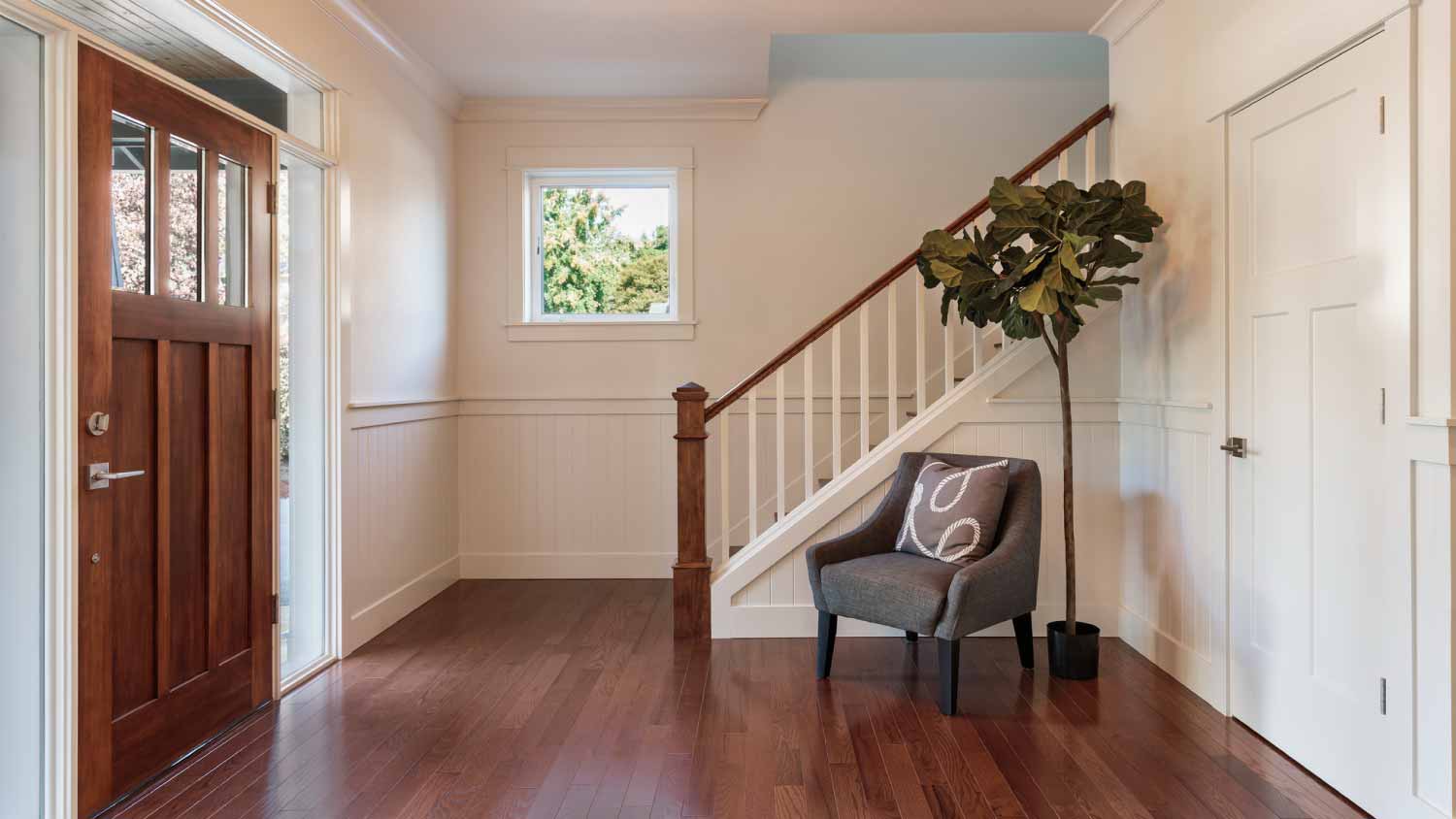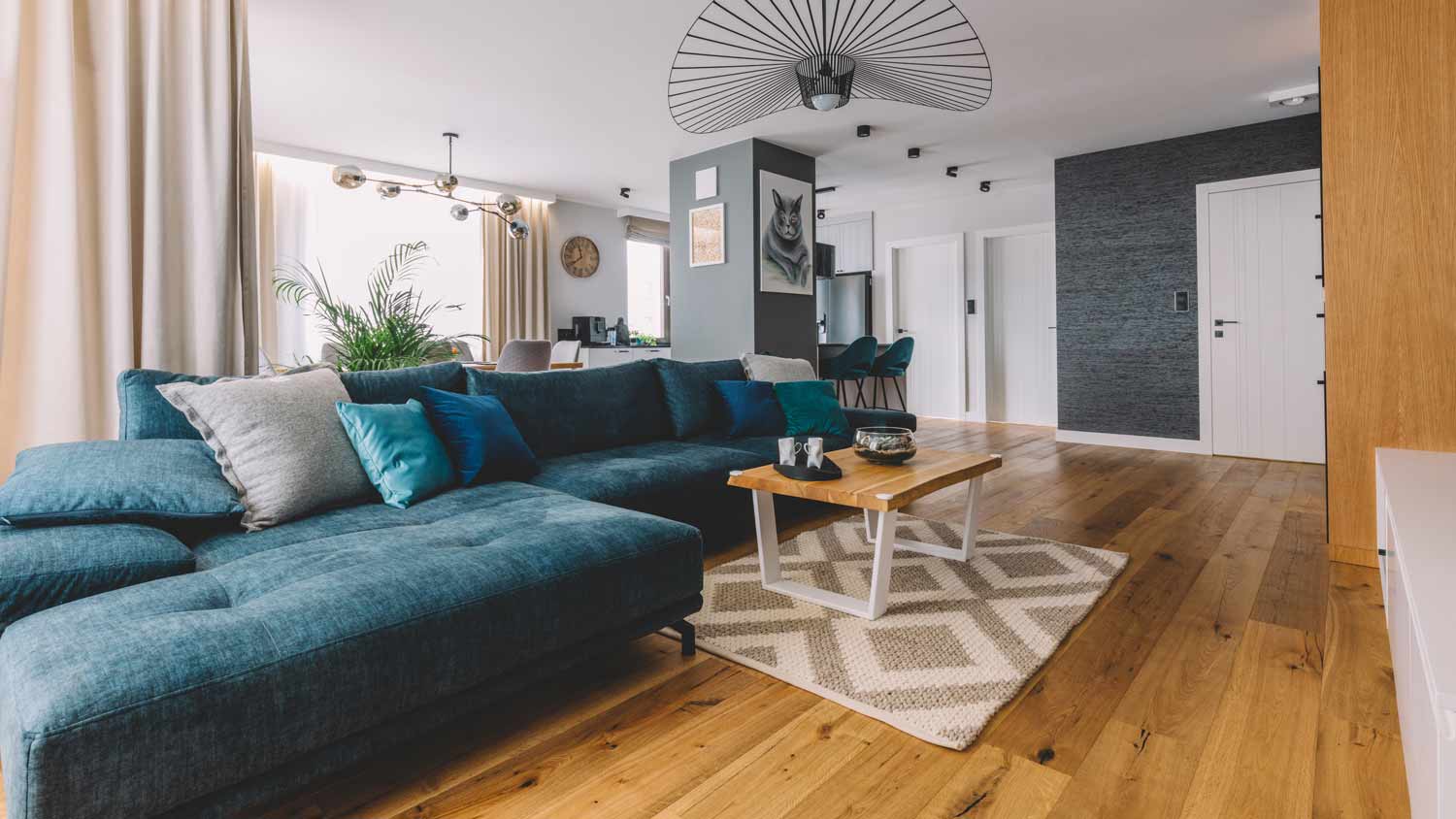6 Standout Entryway Flooring Ideas That Will Wow Your Guests
These flooring options stand the test of time, dirt, and grime


When choosing among different entryway or mudroom flooring options, you’ll need to consider materials that will stand up to the dirt and grime that gets tracked in season after season. Sure, a layer of floor mats could do the trick, but ideally, you want something that is as attractive as it is durable. Here are six entryway flooring ideas to transform your space.
1. Porcelain Tile

Porcelain tiles are more than up to the task of providing a sturdy surface in high-traffic areas. It’s a dense, manufactured tile that’s made from kaolin clay and typically sand and feldspar. Its composition makes it a durable material that can withstand any entryway demands while mimicking popular materials such as hardwood and slate.
| Pros | Cons |
|---|---|
| Easy to clean and maintain | Difficult to cut |
| Water-, stain-, scratch-, and etch-resistant | Expensive installation |
| 50-year life span | Requires special setting material |
Cost
Porcelain tiles cost around $10 to $65 per square foot to install, including labor. Porcelain tile installation typically costs $3 to $40 per square foot without labor. The actual cost you’re likely to spend depends on the type of tile, its class, and its porosity rating.
2. Ceramic Tile
Similar to porcelain, ceramic tile is a worthwhile mudroom flooring option. It’s composed of earthenware material and fired at temperatures of at least 1,800 degrees Fahrenheit in a kiln. Homeowners love it because it can resemble hardwood or stone (just without the price).
| Pros | Cons |
|---|---|
| Easier to install than porcelain | Not as durable as porcelain |
| Great for warm climates | Porous and vulnerable to water and stains |
| More budget-friendly than porcelain | Cold floor can be uncomfortable |
| Can last for decades | Requires frequent maintenance |
| Versatile styling | Slippery |
Cost
Ceramic tile costs about $2 to $40 per square foot to install, including labor. Like porcelain tiles, factors such as the type, class, and porosity rating will impact its cost. If you want to DIY this project, you can save around $2 per square foot.
3. Luxury Vinyl Tile or Luxury Vinyl Plank

Even though “luxury” is in the name, you won’t bust your budget with this flooring option. Luxury vinyl tiles and planks are more economical than ceramic tiles. Also known as LVT and LVP, this vinyl flooring is designed with resins, plasticizers, fungicides, and UV stabilizers. These components create a durable mudroom flooring material.
| Pros | Cons |
|---|---|
| Waterproof | Damaged flooring must be fully replaced |
| Doesn’t require grout | Not consistent—some options are more durable than others |
| Available in many colors and styles | Can fade if exposed to direct sunlight |
| More cost-efficient than tile flooring | Might not add to your resale value |
| Resistant to scratches and stains | Might show bumps and lumps on the subfloor if not smoothed out before installation |
Cost
Vinyl planks and tiles both cost just $2 to $5 per square foot, with an additional $3 to $10 per square foot to install. Vinyl flooring usually requires a vapor barrier for extra durability and stability, which can add to this project’s cost. Additional factors such as the type of flooring, installation method, and your subflooring’s existing condition can also impact the cost.
4. Laminate Flooring

If you like hardwood floors, laminate flooring offers a similar look that is much easier to maintain in high-traffic areas. Laminate flooring is made from layers of composite wood with a top layer that looks like hardwood. But unlike hardwood, it is far more resistant to scratches, stains, and other wear and tear.
| Pros | Cons |
|---|---|
| Resistant to scratches, stains, and dents | Will need to be replaced if heavily damaged |
| Low-maintenance | Vulnerable to standing water |
| DIY-friendly installation | Not all laminate flooring is waterproof |
Cost
Laminate flooring costs around $2 to $10 per square foot, depending on the type of laminate flooring you want to install. For instance, if you want maple laminate flooring, you can expect it to be on the lower end of this range, averaging around $2 to $6 per square foot. But if hickory flooring is more your style, budget around $4 to $10 per square foot.
5. Stone Flooring
If you’re looking for a durable, long-lasting material for your mudroom flooring, you’d be hard-pressed to find one that competes with natural stone. Not only does it offer a one-of-a-kind look, but natural stone can absorb and radiate heat, which is perfect for cooler climates. Natural stone flooring is typically available in marble, granite, slate, limestone, and travertine.
| Pros | Cons |
|---|---|
| Unique, natural look | Not a budget-friendly option |
| Easy to maintain when sealed | Prone to chipping |
| Can increase home’s resale value | Sealed stone is slippery |
Cost
Stone flooring costs anywhere from $5 to $140 per square foot, depending on the type of stone you want. Granite flooring is typically on the lower end, costing $5 to $15 per square foot. Meanwhile, quartzite costs $45 to $75 per square foot.
6. Concrete Flooring
When searching for the best flooring for mudrooms, concrete isn’t typically the first material homeowners consider. But that doesn’t mean it’s only good for your driveway. It’s a strong, durable material that’s a solid option for mudrooms and entryway flooring.
| Pros | Cons |
|---|---|
| Sealed flooring is easy to clean | Requires frequent resealing |
| Durable against stains, scratches, and impacts | Hard flooring |
| Offers natural insulation | Cracks over time |
Cost
Concrete flooring costs $2 to $16 per square foot on average. However, it can cost as much as $30 per square foot based on factors such as the type of finish and concrete grading. Also, if there’s any prep work required, you can add that to the total cost.
What to Look for in Mudroom and Entryway Flooring
Installing new flooring can be a big project, so you’ll want to make sure you choose the right materials based on both your budget and needs. Here are a few things you should consider when looking at flooring options:
Moisture Resistance
Between rainy days and snowstorms, your entryway flooring needs to be up to the task of withstanding any moisture you and your family track indoors.
Low Maintenance
Since your mudroom or entryway will likely see a lot of dirt, debris, and muddy shoes, your flooring choice should be easy to clean. Consider stone or porcelain for easy cleaning.
Scratch and Stain Resistance
Your entryway is a high-traffic area that’ll experience a lot of wear and tear, so you’ll want a durable material that won’t crumble under pressure. Porcelain, LVP, and concrete are great picks.
Aesthetics
Your home’s entrance is the first place anyone sees when they walk into your home, so it doesn’t hurt to look into some stylish entryway or mudroom ideas and make it a focal point you’re happy to step into.
Functionality
Not everyone has the same needs. Some flooring options work wonders for families who need more durability than style. But that same flooring option might not suit you if your mudroom is located in a part of your home you only use when entertaining.
Fortunately, you have lots of options to get the best flooring for your entryway or mudroom.
Types of Mudroom Flooring to Avoid

Unlike low-traffic areas like your attic flooring, not every material is the best for your entryway or mudroom. You should avoid some options since they can be more of a hassle than they’re worth. Let’s look at a few flooring materials that aren’t an excellent fit for your home’s entry space.
Hardwood Flooring
Gleaming hardwood floors are a glorious sight to return home to each day. However, moisture and puddles from dripping raincoats and snowy boots pose a problem.
While you don’t have to completely rule out hardwood floors for your entryway or mudroom, you’ll have to ensure they’re sealed well to hold up to any moisture and that they’re dried off quickly when they get wet. If you love the look of traditional hardwood floors, then go for it, but be sure to add a plastic shoe tray and floor mat to help stop wet footwear in its tracks.
Carpet Flooring
While some homeowners opt for carpet in at least one area in their home, the entryway or mudroom isn’t one we recommend. Carpet flooring is like a sponge and will capture and trap any water or moisture, potentially causing mold growth.
Also, these are high-traffic areas and can lead to noticeable wear and tear that you’ll constantly need to clean and eventually replace, which is worth noting when planning a home addition.
DIY vs. Hiring a Professional for Entryway and Mudroom Flooring
With so many flooring options on the market, it’s easy to get overwhelmed. And if you don’t have an existing one, mudroom additions cost $10,000 on average, so you’re probably looking for ways to save money on this project. However, we recommend leaving this job to the pros.
An experienced professional will have installed countless floors and knows not only what types are right for your home, but also the trends and styles that homeowners want. This will be helpful for you, particularly if you are looking to sell your home in the next few years.
No matter which type of entryway or mudroom flooring you decide is best for your home, you’ll want to make sure it’s made of high-quality materials and installed correctly. Many types of flooring, including luxury vinyl planks, can be completed as a DIY project, but a professional installer can usually get the job done faster and with greater precision.
In the end, you want entryway or mudroom flooring that looks attractive and can stand up to the impact of foot traffic for many years. To choose the best flooring for entryways and mudrooms, talk to a flooring contractor in your area.
Barbara Bellesi Zito contributed to this piece.

.jpg?impolicy=leadImage)













